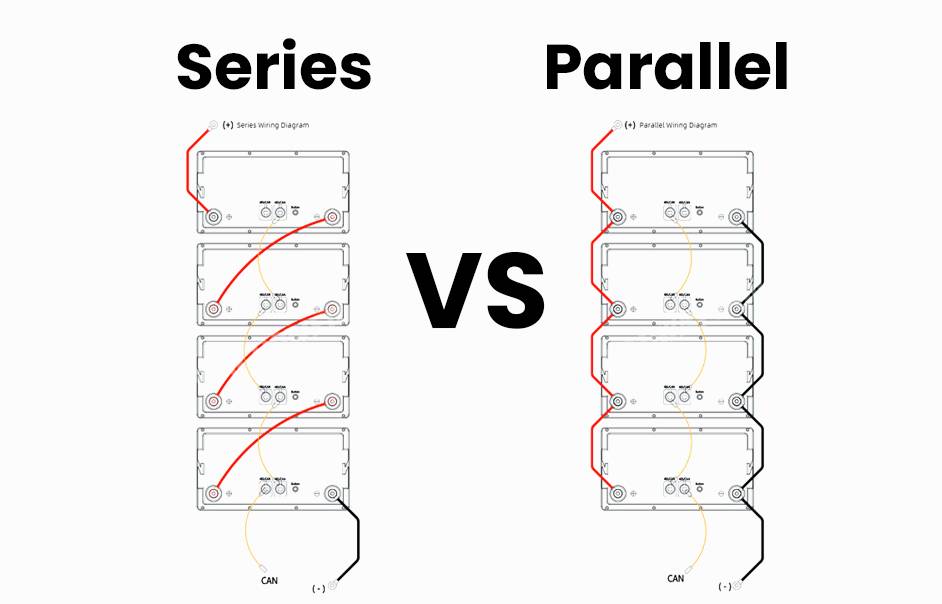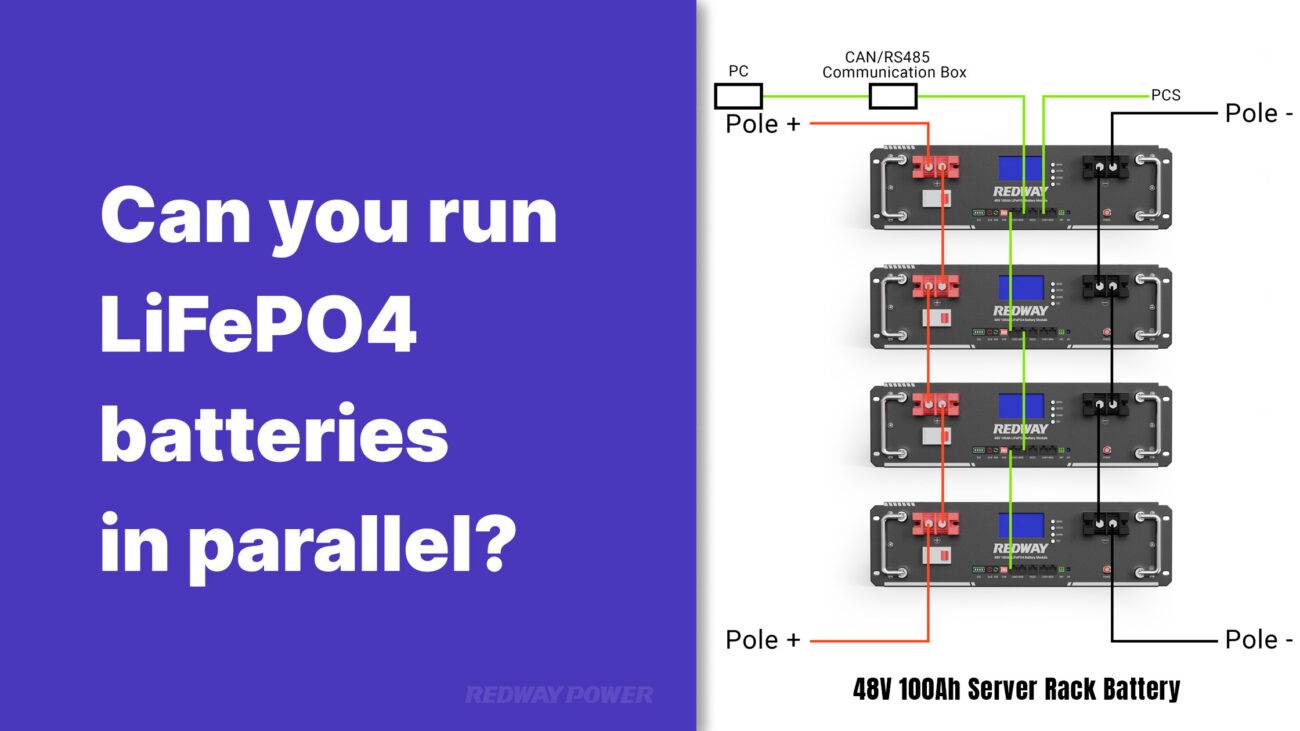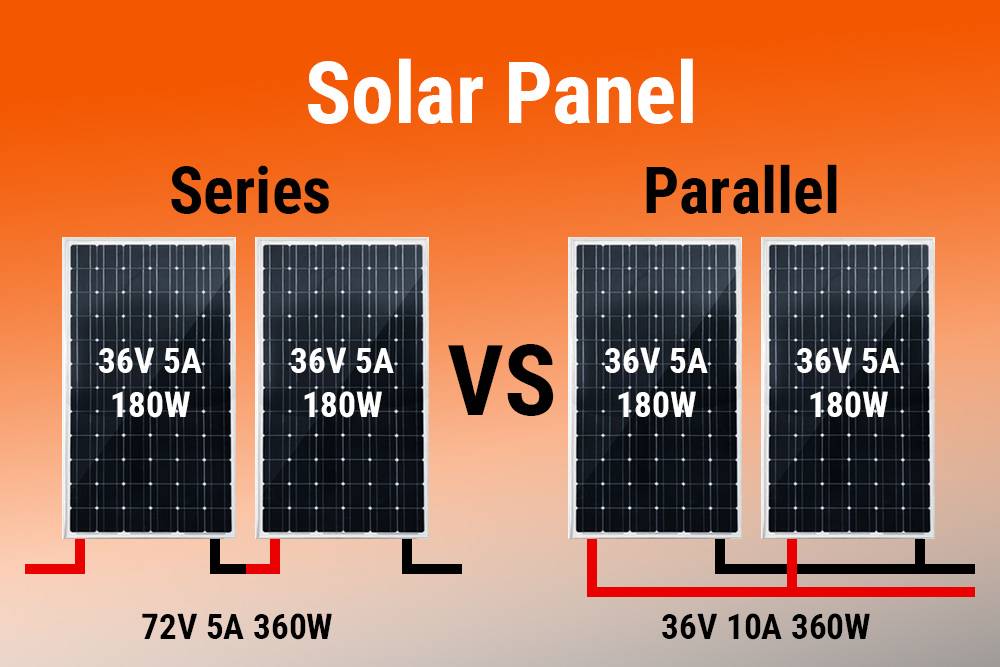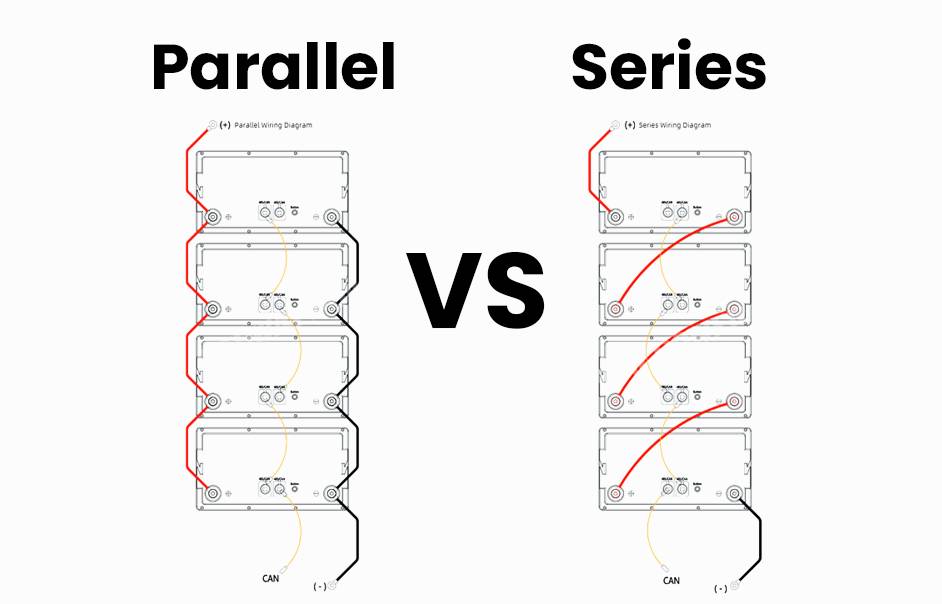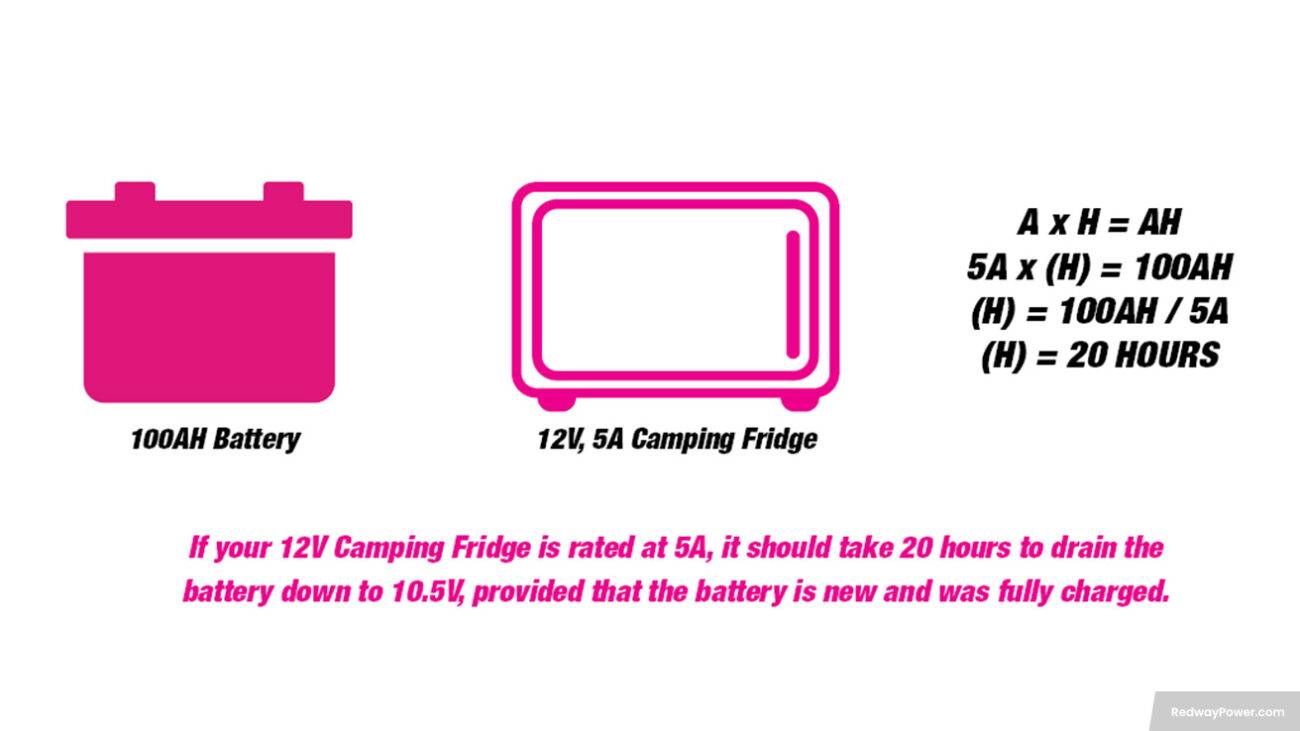Empower your understanding of batteries by exploring the essential methods of connection: series and parallel. Whether it’s for your smartphone, car, or renewable energy systems, knowing how to connect batteries is key. This blog post delves into definitions, benefits, and practical applications of series and parallel connections. Gain valuable insights to confidently choose the right method for your needs. Let’s plunge into the electrifying world of battery connections and charge ahead with knowledge!
Also check:
Wiring Batteries in Series vs Parallel, Which is Better?
Should Boat Batteries Be In Parallel?
RV Solar Panels, All You Need to Know
Solar Panel Series vs Parallel: Which is Better?
Batteries Wired in Series
Batteries Wired in Series: To wire batteries in series, connect the positive terminal of each battery to the negative terminal of the next. Measure the total output voltage between the first battery’s negative terminal and the last battery’s positive terminal.
For instance, let’s consider two 100 Ah batteries wired in series. The first battery’s positive terminal connects to the second battery’s negative terminal, resulting in a system voltage of 24 volts and a total capacity of 100 Ah.
In another example with three batteries wired similarly, the system voltage becomes 36 volts, while the capacity remains at 100 Ah.
Advantages of wiring batteries in series include reduced system current, enabling the use of thinner wiring and experiencing less voltage drop. This setup also allows for increased power efficiency, as demonstrated by lower current draw and increased solar charge controller capacity.
However, a drawback of this configuration is the inability to access lower voltages without a converter. All equipment must operate at the higher voltage, or additional converters are necessary for using 12V appliances.
How Many Batteries Can I Wire In Series?
The number of batteries you can wire in series depends on the voltage requirements of your system and the voltage rating of each individual battery. When batteries are wired in series, their voltages are additive.
For example, if you have four 12-volt batteries and wire them in series, the total system voltage would be 48 volts (12 volts * 4 batteries).
However, it’s important to ensure that the total voltage does not exceed the maximum voltage rating of your system components, including inverters, charge controllers, and other devices. Exceeding the maximum voltage could damage these components or pose a safety hazard.
Always consult the specifications of your system components and follow manufacturer recommendations when determining how many batteries you can wire in series.
Batteries Wired in Parallel
Batteries Wired in Parallel: To wire multiple batteries in parallel, connect all the positive terminals together and all the negative terminals together. This setup allows for measuring the system output voltage across any two positive and negative battery terminals.
For instance, consider two 100 Ah batteries wired in parallel. Both batteries’ positive terminals are connected, as are their negative terminals. This configuration results in a system voltage of 12 volts and a total capacity of 200 Ah.
In another example with three batteries wired similarly, the total capacity increases to 300 Ah while maintaining a system voltage of 12 volts.
Advantages of wiring batteries in parallel include extended runtime without changing the voltage. Adding batteries in parallel increases the available runtime linearly—doubling with two batteries, tripling with three, and so forth. Additionally, if one battery fails, the others in the system can continue providing power.
However, a drawback of this configuration is the lower system voltage, leading to higher current draw. This necessitates thicker cables and results in more voltage drop. Operating larger power appliances and generation systems at lower voltages becomes more challenging and less efficient.
How Many Batteries Can I Wire In Parallel?
The number of batteries you can wire in parallel depends on your system’s capacity needs and the amp-hour (Ah) rating of each battery. When batteries are wired in parallel, their capacities add up while the voltage remains the same.
For example, if you have four 100 Ah batteries and wire them in parallel, the total capacity of your system would be 400 Ah (100 Ah * 4 batteries) at the same voltage.
However, there are practical limits to how many batteries you can wire in parallel. It’s important to consider the size of your system, the available space for batteries, and the charging capacity of your charging source.
Additionally, wiring too many batteries in parallel can increase the risk of imbalance between the batteries, leading to uneven charging and discharging, which can reduce the overall lifespan of your battery bank.
Always consult the specifications of your batteries and follow manufacturer recommendations when determining how many batteries you can wire in parallel for your system.
Comparing Series vs Parallel Connections
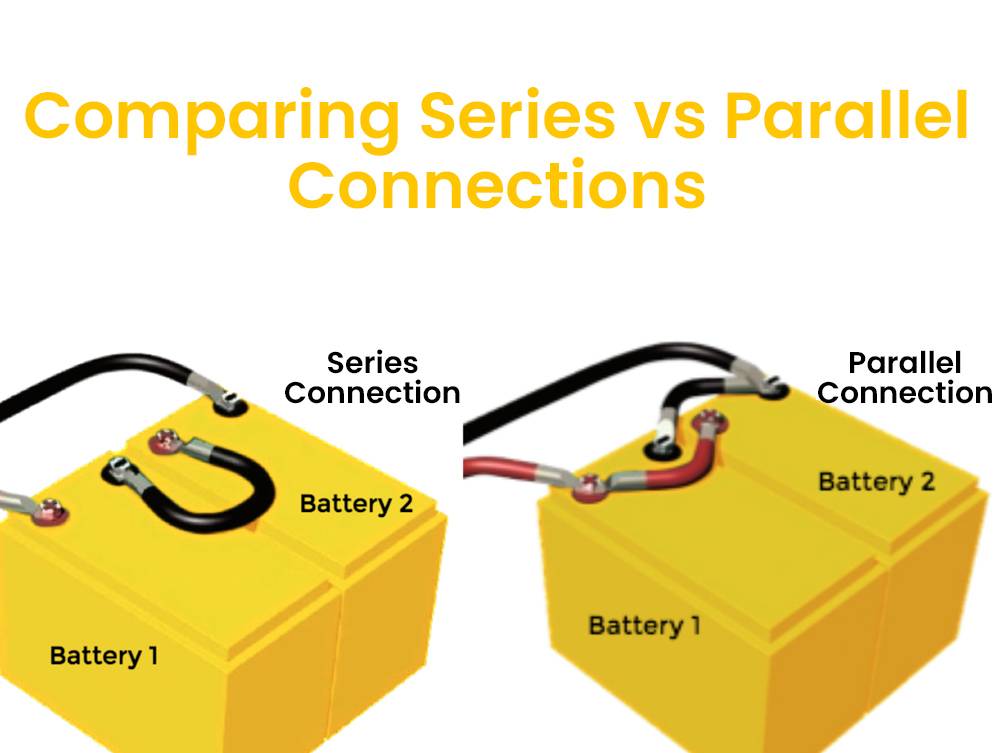
When it comes to connecting batteries, there are two common methods: series and parallel connections. Both options have their own benefits and considerations, so let’s take a closer look at how they compare.
In a series connection, batteries are connected end-to-end, creating a chain-like configuration. This increases the total voltage of the battery bank while keeping the capacity constant. It’s like adding the voltage of each battery together to get a higher overall voltage output. This can be useful in applications that require higher voltages, such as electric vehicles or solar power systems.
On the other hand, parallel connections involve connecting batteries side by side to increase the overall capacity while maintaining a constant voltage level. This means that more energy can be stored and delivered over a longer period of time. Parallel connections are commonly used in applications where high current is required, like backup power supplies or marine electronics.
So which connection method is right for you? Well, it depends on your specific needs and requirements. If you need higher voltage output without increasing capacity significantly, then series connection might be suitable for you. On the other hand, if you need more energy storage and increased capacity without changing the voltage level drastically, then parallel connection could be the way to go.
Before making your decision though, there are several factors to consider such as cost implications (series connections may require additional components), available space (parallel connections may require more physical space), maintenance requirements (series connections may have greater complexity) and desired performance characteristics.
Ultimately both series and parallel connections have their own advantages depending on your application needs; it’s important to carefully evaluate these factors before determining which method suits your requirements best!
Stay tuned for our next blog section where we will discuss practical applications of both series and parallel connections!
Can You Wire Batteries in Series and Parallel?
While you can’t directly wire identical batteries in both series and parallel due to the risk of short-circuiting, you can connect multiple sets of batteries in series and then link these sets in parallel. This allows for the creation of a larger battery bank with a higher voltage output.
For instance, two batteries are wired in series to generate 24V. Then, this series-connected set is joined in parallel with another set of 24V batteries. Each set of batteries in series functions as a single unit. To establish a parallel connection, you need to replicate the voltage of the initial set of batteries.
Similarly, consider the illustration of heated lithium batteries arranged in a series-parallel setup. This configuration results in a 24V 200AH battery bank. Although the amp-hour capacity per battery is reduced, the overall power output remains constant due to the increased voltage.
Charging Batteries in Series vs Parallel
When it comes to charging batteries, whether they are connected in series or parallel, the process remains essentially the same. Here’s how it works:
For batteries wired in series, begin by connecting the positive charger cable to the positive terminal of the first battery in the series. Then, attach the negative charger cable to the negative terminal of the last battery in the series. This ensures that the entire series of batteries receives an even charge.
Similarly, for batteries wired in parallel, follow the same procedure. Connect the positive charger cable to the positive terminal of the first battery, and connect the negative charger cable to the negative terminal of the last battery in the parallel arrangement.
Additionally, consider using a multi-bank battery charger if available. This can potentially reduce charge times for both series and parallel battery banks. However, always consult the manufacturer’s recommendations to ensure the optimal charging method for your specific batteries.
Factors to Consider Before Choosing a Connection Method
The factors outlined in the text are indeed important considerations when choosing between series and parallel connection methods for batteries. Let’s break down the accuracy of each point:
- Required Voltage: Accurate. Series connections increase voltage, while parallel connections maintain voltage but increase capacity.
- Battery Types: Accurate. It’s crucial to ensure compatibility in terms of capacity and discharge rates among connected batteries.
- Safety Considerations: Accurate. Series connections can lead to higher currents, requiring proper protection to prevent overheating or explosions.
- Maintenance Requirements: Accurate. Parallel connections can simplify maintenance since each battery operates independently.
- Cost Considerations: Accurate. Series connections may offer higher voltages at lower costs, but they can also involve increased complexity and installation costs.
Overall, the text effectively highlights the key factors that should be considered before choosing a connection method for batteries. It provides valuable insights into the decision-making process, helping readers make informed choices based on their specific needs and requirements.
Practical Applications of Series and Parallel Connections
There are numerous practical applications where series and parallel connections of batteries come into play. Let’s explore some of these applications:

1. Electric Vehicles: Series connections are commonly used in electric vehicles to achieve higher voltage levels required for efficient operation. By connecting multiple battery cells in series, the overall voltage can be increased while maintaining a suitable current level.
2. Solar Power Systems: In solar power systems, batteries are often connected in both series and parallel configurations. Series connection helps increase the system’s voltage capacity, enabling it to store larger amounts of energy from solar panels. On the other hand, parallel connection allows for increased current capacity, ensuring a stable power supply.
3. Uninterruptible Power Supplies (UPS): UPS systems use both series and parallel connections to ensure continuous power supply during blackouts or fluctuations in electricity flow. Series connections help achieve higher voltages needed for backup power generation, while parallel connections offer extended runtime by increasing total battery capacity.
4. Off-Grid Energy Storage: Remote areas that lack access to grid electricity rely on off-grid energy storage systems powered by batteries connected in series or parallel configurations depending on specific requirements.
5. Portable Electronics: Many portable devices such as laptops, smartphones, and cameras utilize batteries connected in both series and parallel setups to balance between desired voltage levels and long-lasting performance.
By understanding the practical applications of series and parallel battery connections, you can better determine which method suits your specific needs within various domains like transportation, renewable energy sources, emergency backup solutions, remote locations with limited access to electricity grids or even small personal gadgets we use daily!
Remember that each application may have its own unique set of considerations when deciding whether a series or parallel connection is most appropriate.
FAQs
What is the difference between connecting batteries in series vs in parallel?
Connecting batteries in series means connecting the positive terminal of one battery to the negative terminal of another, increasing the total voltage while maintaining the same capacity. Connecting batteries in parallel means connecting all the positive terminals together and all the negative terminals together, increasing the total capacity while maintaining the same voltage.
How do you connect a battery in series and parallel?
To connect batteries in series, connect the positive terminal of one battery to the negative terminal of the next battery. To connect batteries in parallel, connect all the positive terminals together and all the negative terminals together.
Do batteries last longer in series or parallel?
Batteries typically last longer when connected in series because they share the load evenly, resulting in more efficient usage of their capacity. However, this depends on factors such as the specific application and how well the batteries are balanced.
What are the advantages of connecting the batteries in series?
Connecting batteries in series increases the total voltage, which can be beneficial for applications requiring higher voltage levels. Additionally, batteries in series can provide more stable voltage output and can be easier to manage in certain configurations.
What are the rules for series and parallel circuits?
In series circuits, the total voltage is the sum of the individual voltages, and the total resistance is the sum of the individual resistances. In parallel circuits, the total voltage is the same across all components, and the total resistance decreases as more components are added.
Why do batteries need to be connected in parallel?
Batteries are connected in parallel to increase the total capacity available. This is useful in applications where a higher capacity is required without increasing the voltage.
Why is it better to connect batteries in series than in parallel?
Connecting batteries in series allows for higher voltages, which can be advantageous in certain applications such as powering electric vehicles or high-powered electronics. Additionally, series-connected batteries tend to discharge more evenly compared to parallel-connected batteries.
What are the pros and cons of batteries in parallel vs series?
Batteries in parallel provide increased capacity and can handle higher current loads, but they may be more prone to imbalance issues. Batteries in series offer higher voltage and more stable voltage output but require careful monitoring to ensure balanced charging and discharging.
Do batteries in series drain equally?
In theory, batteries in series should drain equally because they share the load. However, in practice, factors such as differences in internal resistance, capacity, and age can cause slight imbalances in the discharge rates. It’s essential to monitor and balance batteries in series to ensure they discharge evenly.

